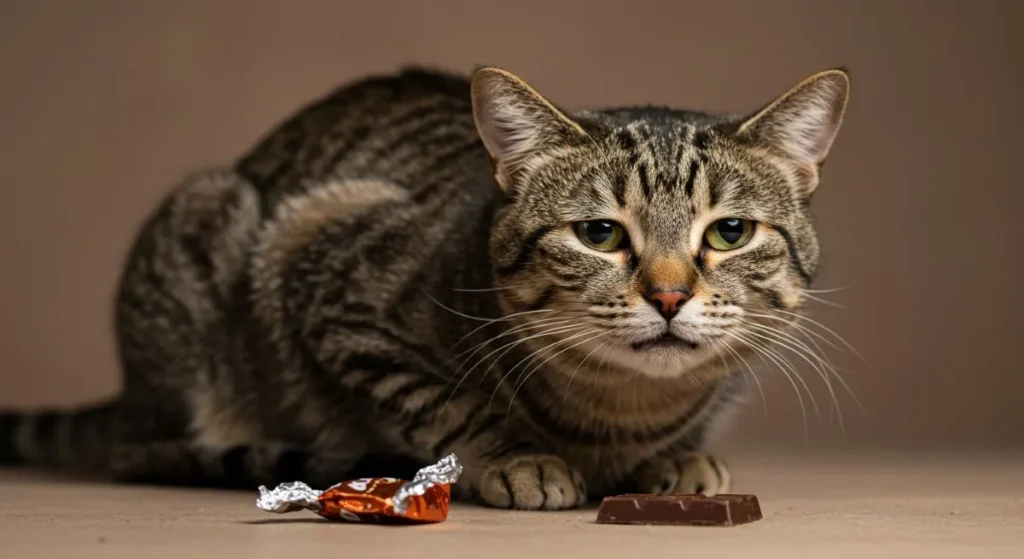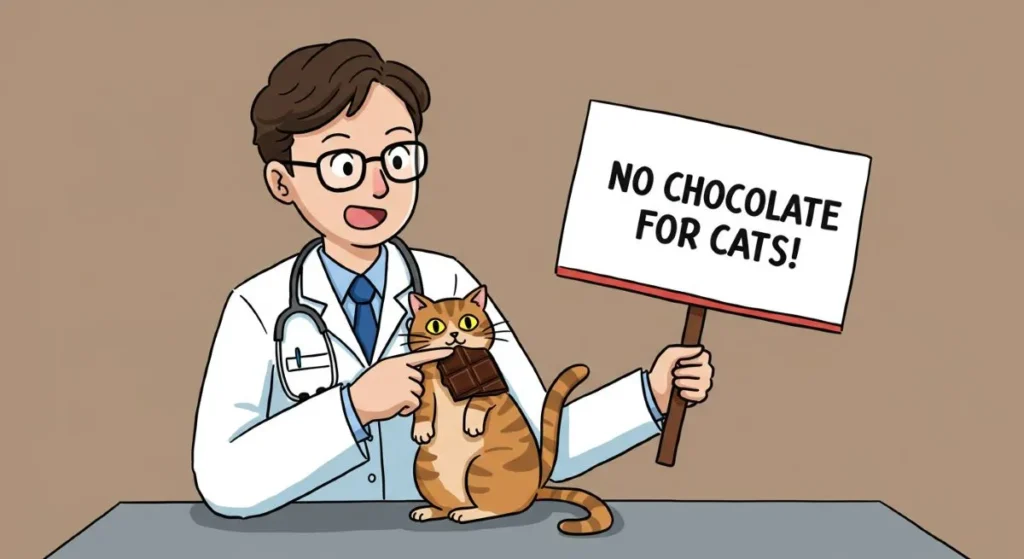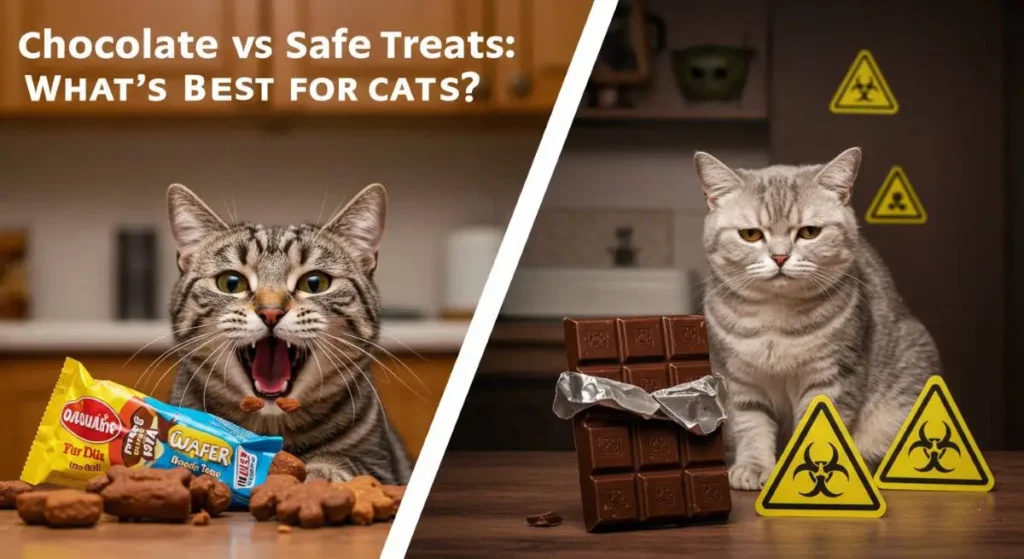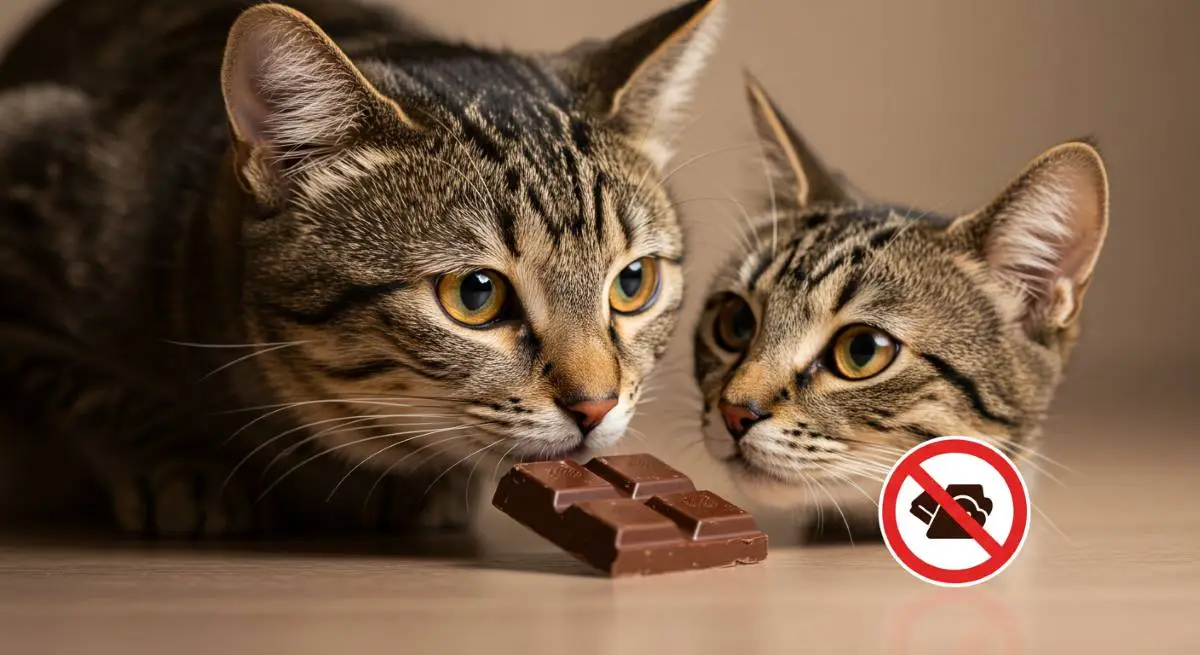Table of Contents
Chocolate may be a delicious treat for humans, but can cats have chocolate safely? The short answer is no—chocolate is highly toxic to cats and can lead to severe health complications, even in small amounts. The dangers come from compounds like theobromine and caffeine, which a cat’s digestive system cannot process effectively. Unfortunately, many pet owners are unaware of just how dangerous chocolate can be for their feline friends.
In this guide, we’ll explore five life-saving facts about why chocolate is harmful to cats, the symptoms of poisoning, and what to do if your cat accidentally eats chocolate. Understanding these risks can help you keep your furry companion safe and healthy.
Can Cats Have Chocolate? Understanding the Danger

Chocolate is a beloved treat for humans, but can cats have chocolate? The answer is a definitive no. Chocolate contains both theobromine and caffeine, which are harmful compounds that can be toxic to cats. Unlike humans, cats cannot metabolize these compounds effectively, leading to serious health risks—even from small amounts. While some pet owners may assume a tiny piece won’t hurt, even a small dose of chocolate can cause poisoning in felines.
Understanding why chocolate is dangerous for cats is crucial for every pet owner. Below, we break down the specific reasons chocolate is toxic, how cats process it differently, and what makes these ingredients so harmful.
Why Chocolate Is Toxic to Cats
The primary reason chocolate is unsafe for cats is its toxic chemical composition. Chocolate contains theobromine and caffeine, both of which are classified as methylxanthines. These stimulants affect the nervous system, heart, and muscles, causing dangerous side effects in cats.
Theobromine, in particular, stays in a cat’s system for a long time, making it difficult for their body to process and eliminate. As a result, even a small amount can build up to toxic levels, leading to symptoms such as vomiting, tremors, rapid breathing, and seizures. Unlike humans and even dogs, cats lack the necessary enzymes to break down these compounds efficiently, making them extremely vulnerable to chocolate poisoning.
The Role of Theobromine and Caffeine in Toxicity
Both theobromine and caffeine are present in chocolate, but theobromine is the biggest threat. It acts as a stimulant, increasing heart rate, blood pressure, and excitability in cats. While humans and dogs can process theobromine relatively quickly, a cat’s body eliminates it at a much slower rate, leading to toxic accumulation.
Caffeine also contributes to chocolate poisoning by overstimulating the nervous system. Even a small amount can cause restlessness, hyperactivity, and increased heart rate in cats. Since cats are much smaller than humans, it takes far less caffeine and theobromine to cause severe poisoning, making chocolate consumption a life-threatening situation.
How Cats Process Chocolate Differently Than Humans
Cats’ bodies are not designed to digest methylxanthines like theobromine and caffeine. Unlike humans, who can break down and excrete these chemicals relatively quickly, cats lack the necessary liver enzymes to metabolize them efficiently. This means that toxic substances linger in their system longer, increasing the risk of dangerous side effects.
Additionally, cats do not have a natural craving for sweets since their taste buds are not designed to detect sugar. However, their curiosity may lead them to lick, chew, or eat chocolate-containing foods, especially if it’s mixed with dairy or other appealing ingredients. This makes it essential for pet owners to keep all chocolate products out of reach to prevent accidental poisoning.
Signs and Symptoms of Chocolate Poisoning in Cats
Chocolate toxicity in cats is a severe condition that can be life-threatening if not addressed quickly. Since cats are small and their bodies cannot process theobromine and caffeine, even a small amount of chocolate can trigger severe symptoms. Recognizing the early warning signs of chocolate poisoning can mean the difference between a quick recovery and a dangerous medical emergency.
The severity of symptoms depends on the type and amount of chocolate consumed, as well as the size and overall health of the cat. Below, we break down the early, severe, and emergency signs of chocolate toxicity in cats so you know when to take action.
Early Symptoms: Vomiting, Diarrhea, and Restlessness
One of the first signs of chocolate poisoning in cats is gastrointestinal distress. If a cat eats chocolate, their body will immediately try to get rid of the toxic substances, leading to vomiting and diarrhea. These symptoms usually appear within 2 to 4 hours after ingestion. Vomit may contain traces of chocolate or foam, while diarrhea may be watery and persistent.
In addition to stomach upset, affected cats often exhibit restlessness and hyperactivity. The caffeine and theobromine in chocolate stimulate the nervous system, causing a cat to become unusually energetic, anxious, or unable to settle down. If your normally calm cat suddenly starts pacing, meowing excessively, or acting agitated, it could be a sign of early-stage chocolate poisoning.
Severe Symptoms: Seizures, Rapid Heart Rate, and Coma
As the toxins continue to build up in the bloodstream, the symptoms become more severe and life-threatening. One of the most dangerous effects of chocolate poisoning is a rapid heart rate (tachycardia), which can lead to heart arrhythmias or even cardiac arrest. Cats may also experience tremors, muscle twitching, and seizures as their nervous system becomes overstimulated.
At this stage, cats may also develop increased thirst (polydipsia) and frequent urination (polyuria) as their kidneys attempt to flush out the toxins. However, as poisoning progresses, the cat’s body may start to shut down, leading to weakness, difficulty breathing, and, in extreme cases, coma. If you observe any of these warning signs, seek urgent veterinary assistance without delay.
When to Seek Emergency Veterinary Care
The moment you suspect that your cat has eaten chocolate, do not wait for symptoms to appear—call your veterinarian or a pet poison control hotline right away. Even if your cat only consumed a small amount, the toxic effects can escalate quickly, and professional medical intervention may be necessary.
Veterinary treatment for chocolate poisoning may include inducing vomiting, administering activated charcoal to absorb toxins, IV fluids to flush the system, and medications to control heart rate and seizures. In severe cases, cats may require hospitalization and continuous monitoring.
Since chocolate toxicity can be fatal, early action is crucial. If you’re ever unsure, it’s always better to err on the side of caution and contact a vet immediately.
Types of Chocolate and Their Toxicity Levels
Not all chocolate is equally toxic to cats. The risk level varies based on the type of chocolate, its caffeine and theobromine concentration, and how much your cat has ingested. Darker chocolates tend to be the most dangerous, while white chocolate is the least toxic but still not safe for cats.
Understanding the different types of chocolate and their toxicity levels can help cat owners assess the risk and take appropriate action if their cat accidentally consumes chocolate.
Dark Chocolate: The Most Toxic for Cats
Dark chocolate contains the highest concentration of theobromine and caffeine, making it the most dangerous for cats. Even a tiny piece can lead to severe poisoning.
Since dark chocolate has a high cocoa percentage, the risk of toxicity is significantly greater than with other types of chocolate. If a cat consumes dark chocolate, immediate veterinary attention is required.
Milk Chocolate: Still Dangerous but Less Toxic
Milk chocolate contains less theobromine than dark chocolate but is still toxic to cats. Due to its sugar and dairy content, milk chocolate can also cause digestive issues like vomiting and diarrhea.
Although milk chocolate poses a lower risk than dark chocolate, it can still cause dangerous symptoms if consumed in moderate amounts. Cats should never be given milk chocolate under any circumstances.
White Chocolate: The Least Toxic, but Not Safe
Compared to milk and dark chocolate, white chocolate has significantly lower levels of theobromine. However, it is still unhealthy for cats due to its high fat, sugar, and dairy content.
While white chocolate is less likely to cause poisoning, it can still lead to digestive upset, obesity, and pancreatitis if consumed regularly. It is best to keep all chocolate products away from cats.
Other Chocolate-Based Products That Are Harmful
Many foods contain hidden chocolate ingredients, making them just as toxic as chocolate itself. These include chocolate cakes, brownies, cookies, chocolate-covered nuts, and cocoa powder.
Cocoa powder is particularly dangerous because it has a high concentration of theobromine. Even licking small amounts from a spilled container can be life-threatening for a cat.
Always read ingredient labels carefully and ensure that all chocolate-based products are kept far out of reach of your feline friend.
What to Do If Your Cat Eats Chocolate?

If you suspect your cat has eaten chocolate, acting fast is crucial. Even small amounts can cause serious toxicity, and delaying treatment may lead to life-threatening complications. Knowing the right steps to take can save your cat’s life.
Immediate Steps to Take at Home
First, stay calm and try to determine how much chocolate your cat has consumed. Check for missing pieces, wrappers, or crumbs that may indicate ingestion.
Next, remove any remaining chocolate from your cat’s reach to prevent further consumption. If chocolate is on their fur, wipe it off immediately before they try to lick it.
Avoid trying to induce vomiting at home unless specifically instructed by a veterinarian. Some methods can do more harm than good if not performed correctly.
When to Call a Vet or Poison Control Hotline
Contact your veterinarian or a pet poison control hotline as soon as possible. Be ready to provide details such as the type of chocolate, the amount eaten, and your cat’s weight.
If your cat is already showing symptoms like vomiting, restlessness, or tremors, urgent medical care is needed. Time is critical, so seek help immediately.
Pet poison hotlines like ASPCA Animal Poison Control (888-426-4435) or Pet Poison Helpline (855-764-7661) can offer expert guidance.
Treatments for Chocolate Poisoning in Cats
At the vet, treatment will depend on the amount of chocolate ingested and your cat’s condition. If caught early, the vet may induce vomiting or administer activated charcoal to absorb toxins.
For more severe cases, your cat may need IV fluids, medications to control heart rate, and anti-seizure treatments. In extreme cases, hospitalization may be required for close monitoring.
Starting treatment as soon as possible greatly improves the chances of a full recovery. Always err on the side of caution and seek veterinary care immediately if you suspect chocolate ingestion.
Safe Alternatives to Chocolate for Cats

Since chocolate is toxic to cats, it’s essential to find safe and healthy alternatives to satisfy their cravings without putting their health at risk. Many cat-friendly treats offer great taste and nutrition while keeping your feline safe.
Cat-Friendly Treats and Snacks
Instead of chocolate, choose vet-approved cat treats made from real meat, fish, or poultry. Many brands offer treats rich in protein and essential nutrients to support your cat’s health.
Small portions of cooked chicken, turkey, or tuna can also be an excellent reward. Just ensure they are plain, unseasoned, and free from harmful ingredients like garlic or onions.
How to Prevent Accidental Chocolate Ingestion
Keeping chocolate out of reach is the best way to protect your cat. Store all chocolate products in sealed containers or cabinets where your cat cannot access them.
Make sure family members and visitors understand that chocolate is dangerous for cats. Make sure they know never to leave chocolate snacks unattended or offer them to pets.
If you enjoy chocolate desserts, always clean up spills and crumbs immediately to prevent accidental licking or ingestion.
Educating Family Members About Chocolate Dangers
Many pet owners are unaware of how toxic chocolate is to cats. Make it a priority to educate everyone in your household, including children, about the risks.
Remind them that even a small piece of chocolate can cause poisoning and that cats process food differently than humans. Encourage them to stick to pet-safe treats when giving snacks to your cat.
By choosing healthy alternatives and maintaining a chocolate-free environment, you can keep your cat safe while still treating them to delicious and nutritious snacks.
Conclusion About Can Cats Eat Chocolate ?
Chocolate may be a delicious treat for humans, but can cats have chocolate? Absolutely not. Even a small amount can be toxic and life-threatening due to the presence of theobromine and caffeine, which cats cannot metabolize properly. Consuming chocolate can lead to vomiting, diarrhea, seizures, rapid heart rate, and even coma, making it a serious health risk for your feline friend.
If you suspect your cat has eaten chocolate, act immediately by contacting your veterinarian or a pet poison control hotline. Early intervention is crucial to prevent severe complications and ensure a full recovery.
To keep your cat safe, always store chocolate out of reach, educate family members about its dangers, and offer safe, cat-friendly alternatives instead. Understanding why can cats have chocolate is a dangerous question can help prevent accidental poisoning and ensure your cat stays happy and healthy.
FAQ About Can Cats Eat Chocolate ?
Can Cats Eat Chocolate Ice Cream?
No, cats should never eat chocolate ice cream. While the milk and sugar are unhealthy, the chocolate makes it doubly dangerous. Even a small lick can cause theobromine poisoning. Stick to cat-safe treats instead.
Are Some Cat Breeds More Sensitive to Chocolate?
While all cats are at risk, smaller breeds or cats with pre-existing health conditions may show symptoms faster. However, no breed is immune to chocolate toxicity—keep it away from all cats.
Can Cats Eat Chocolate Safely?
No, there’s no safe amount of chocolate for cats. Even a tiny piece can be harmful. Instead, offer vet-approved treats like catnip or freeze-dried meat to satisfy their cravings safely.
Can Cats Eat Chocolate?
No, cats cannot eat chocolate. It contains theobromine and caffeine, which are toxic to cats. Even tiny amounts can cause vomiting, seizures, or death.
Is Chocolate Toxic to Cats?
Yes, chocolate is highly toxic to cats. Theobromine, a compound in chocolate, cannot be metabolized by cats and leads to heart issues, tremors, and kidney failure.
How Long Does It Take for Symptoms to Appear?
Symptoms like vomiting, restlessness, or rapid breathing can start within 6–12 hours. Severe signs (seizures, collapse) require immediate vet care.

